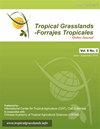Effects of plant spacing and fertilizer level on forage yield and chemical composition of hybrid Urochloa cv. Mulato II grass during the first 150 days of growth under irrigation supplementation, in Chagni Ranch, Awi Zone, Ethiopia
IF 0.7
4区 农林科学
Q3 AGRICULTURE, DAIRY & ANIMAL SCIENCE
引用次数: 0
Abstract
A study was conducted to evaluate the effects of plant spacing and N fertilizer application on dry matter yield and chemical composition of Urochloa hybrid cv. Mulato II grass for the first 150 days after planting. A factorial experiment with 3 urea fertilizer levels (0, 50 and 100 kg/ha) and 4 spacings between plants and rows (20 × 20, 30 × 40, 40 × 60 and 50 × 80 cm) with 3 replications was used. Data collected were dry matter yield (DMY), leaf:stem ratio and chemical analyses, i.e. crude protein (CP), ash, neutral detergent fiber (NDF), acid detergent fiber (ADF) and acid detergent lignin (ADL) concentrations. Results indicated that DMY, leaf:stem ratio, CP%, NDF% and ADF% were significantly (P<0.05) affected by interactions between plant spacing and fertilizer level. However, ash and ADL were significantly (P<0.05) affected only by main effects. The highest DMYs (9.18 t/ha and 8.93 t/ha) were recorded for narrowest plant spacing (20 × 20 cm) with higher urea fertilizer level (100 kg/ha) and narrowest plant spacing (20 × 20 cm) with medium urea fertilizer level (50 kg/ha), respectively. CP% ranged from 14.6 to 20% and leaf:stem ratio from 1.12 to 1.82:1. Similar studies need to be conducted over longer periods to determine to what extent these findings relate to performance over the life of a permanent pasture.株距和施肥量对杂交种草叶草产量和化学成分的影响。埃塞俄比亚阿维区Chagni牧场的Mulato II草在灌溉补充下生长的头150天
研究了株距和施氮量对乌克洛草杂交稻干物质产量和化学成分的影响。Mulato II草种植后的前150天。试验采用3个氮肥水平(0、50和100 kg/ha)和4个株行间距(20 × 20、30 × 40、40 × 60和50 × 80 cm),共3个重复。收集的数据包括干物质产量(DMY)、叶茎比和化学分析,即粗蛋白质(CP)、灰分、中性洗涤纤维(NDF)、酸性洗涤纤维(ADF)和酸性洗涤木质素(ADL)浓度。结果表明:株距和施肥量对DMY、叶茎比、CP%、NDF%和ADF%的影响显著(P<0.05)。而灰分和ADL仅受主效应影响显著(P<0.05)。最窄株距(20 × 20 cm)和最窄株距(20 × 20 cm)施用较高尿素水平(100 kg/ha)和最窄株距(20 × 20 cm)施用中等尿素水平(50 kg/ha)的土壤土壤日活最高,分别为9.18 t/ha和8.93 t/ha。CP%为14.6% ~ 20%,叶茎比为1.12 ~ 1.82:1。类似的研究需要在更长的时间内进行,以确定这些发现在多大程度上与永久牧场的寿命表现有关。
本文章由计算机程序翻译,如有差异,请以英文原文为准。
求助全文
约1分钟内获得全文
求助全文
来源期刊

Tropical Grasslands-Forrajes Tropicales
Agricultural and Biological Sciences-Agronomy and Crop Science
CiteScore
1.60
自引率
0.00%
发文量
36
审稿时长
16 weeks
期刊介绍:
The Journal publishes, in English or Spanish, Research Papers and Short Communications on research and development, as well as contributions from practitioners (Farmer Contributions) and Review Articles, related to pastures and forages in the tropics and subtropics. There is no regional focus; the information published should be of interest to a wide readership, encomprising researchers, academics, students, technicians, development workers and farmers.
In general, the focus of the Journal is more on sown (''improved'') pastures and forages than on rangeland-specific aspects of natural grasslands, but exceptions are possible (e.g. when a submission is relevant for a particularly broad readership in the pasture and forage science community).
The Journal will also consider the occasional publication of associated, but closely related, research in the form of an additional scientific communication platform [e.g. a re-make of the former Genetic Resources Communication series of the former Division of Tropical Crops and Pastures of the Commonwealth Scientific and Industrial Research Organisation (CSIRO), Australia].
Areas of particular interest to the Journal are:
Forage Genetic Resources and Livestock Production[...]
Environmental Functions of Forages[...]
Socio-economic Aspects[...]
Topics within the aforementioned areas may include: Diversity evaluation; Agronomy; Establishment (including fertilization); Management and utilization; Animal production; Nutritive value; Biotic stresses (pests and diseases, weeds); Abiotic stresses (soil fertility, water, temperature); Genetics and breeding; Biogeography and germplasm collections; Seed production; Ecology; Physiology; Rhizobiology (including BNF, BNI, mycorrhizae); Forage conservation; Economics; Multilocational experimentation; Modelling.
 求助内容:
求助内容: 应助结果提醒方式:
应助结果提醒方式:


